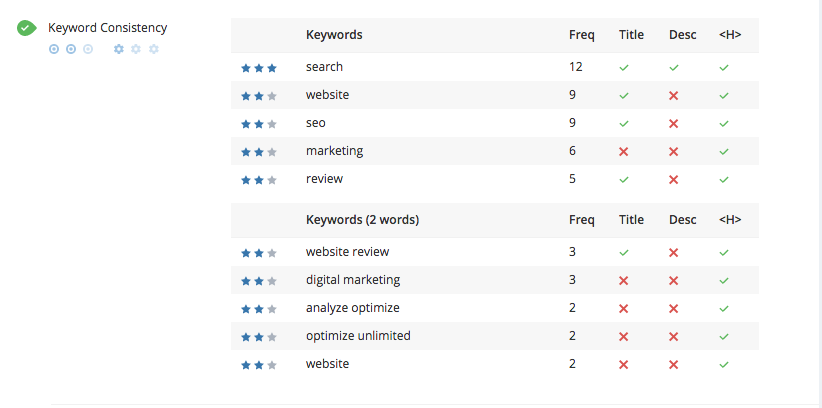
This article is part of an SEO series from WooRank. Thank you for supporting the partners who make SitePoint possible.
Whether you're brand new to search engine optimization, got some experience or you're a seasoned vet, you're probably operating under some faulty assumptions or outdated information you've picked up along the way. Unfortunately, there's a chance you think you're doing everything right but unknowingly hampering your own marketing. As you move forward into the holiday shopping season and the next year (we're already in Q4, people), put these persistent misconceptions to bed so you can get the most out of your digital marketing efforts.
1. SEO Is All about Keyword DensityThis myth is the remnant of a bygone age. In the old days of SEO you could trick search engines into thinking you had a highly relevant page by publishing thin content (just a few hundred words per page) that was crammed with keywords and their synonyms. This type of SEO was struck down by Google's Panda update, which targeted low-quality, thin and duplicated content. Sites that had over optimized took a hit to their rankings and traffic. If you're still operating under the idea that keyword density matters, you'll probably struggle to rank well, and you're providing your visitors with a worse user experience to boot.
That doesn't mean don't optimize your site for a specific keyword. You just need to do it naturally and keep in mind how you're providing value to your users. Places you should still use your keyword are:
When it comes time to write your page content, don't worry about how many times you've used your keyword — search engines don't really look at it that way and if the content is too keyword rich it will make you look bad. Instead, focus on using your keyword in the places mentioned above and throughout the entire page. This is where longer content really pays off: you'll have your keyword and semantically related words naturally appear in different places, which will make your page look better. Measure how consistently you use keywords and related words with a WooRank audit:

Images and videos play a role in SEO in two important ways: Regular search results rankings and image/video search results. Images and videos help your on page SEO in two ways:
Well-optimized images and videos will also open up your page to a new channel of traffic: image and video search results. What's really great about this sort of SEO is that you can double dip here: optimizing your media to help your pages rank will also help them rank in image search results. There are two vital parts of multimedia code to optimize:
Check your image optimization with a WooRank audit to verify that your images have correctly implemented alt attributes.

Ensure that search engines are properly crawling and indexing your images and videos by using the <image> and <video> extension to your XML sitemap. If you've got a lot of images and/or videos, create image and video sitemaps and add them to your site as part of a sitemap index file.
3. Rich Snippets are Bad for MarketersRich snippets, both the Knowledge Graph and Answer Box, are part of Google's effort to enhance search results by interpreting search intent and providing the searched-for information directly in SERPs using semantic search information, gathered from the web in its entirety. These rich snippets have some marketers tearing their hair out. Since Knowledge Graph gathers information from all over the web, it won't always link back to your site.
Additionally, the Answer Box can potentially discourage users from clicking through to your site because they've answered their question directly in the results. However, there are some advantages to appearing in rich snippets, the most obvious being that they allow you to leapfrog anyone who may outrank you for your branded search terms (Knowledge Graph) or other target keywords (Answer Box). Even better, pages that appear in the Answer Box saw a sizable increase in search traffic.
Unfortunately, appearing in the Knowledge Graph doesn't show the same boost in traffic, but you can still use it to your advantage by optimizing where it gets its data to help control the information it displays and keep your users in your ecosystem.
So how do you appear in rich snippets? That depends on which snippet you're talking about. Answer Box relies much more on page content and your site's authority, while optimizing Knowledge Graph means more focus on off page SEO factors.
This myth joined the collective SEO conscience after Google's Penguin update punished sites participating in link building techniques that were maybe not so white hat. This, along with the ascendency of content marketing, caused some SEOs to declare that the days of link building were over and the best way to fill out your backlink profile is by naturally earning links by creating great content. This wasn't exactly wrong, as creating useful articles, videos and infographics is still the most important step of getting links, but the idea that content will earn its own links through quality and social media engagement hasn't panned out.
So what does this mean? Links are still important, as seen by Google's recent addition of Penguin 4.0 to its core algorithm, so you still need to build links on your own using a strategic manual link building strategy. Your link building strategy should include the following parts:
For many the goal of "doing SEO" doesn't get much past "rank number one in Google." If that's your approach to SEO, you're falling prey to the myth that getting to that top spot is a magic bullet for digital marketing. The truth is yes, ranking highly in Google is part of it, but the truth is that to see the results you want, optimizations have to be done as part of a campaign with an overall goal in mind. Ranking number one for "women's shoes" won't do you much good if the majority of people using that keyword are looking for dress shoes and your landing page is optimized for athletic shoes.
So, instead of optimizing your site willy-nilly, take the time to develop a comprehensive SEO strategy. A good SEO strategy will:
If you've been around digital marketing much at all you will have heard the "content is king" mantra hammered home again and again: Creating high quality, useful content will rank well in search results without much help from SEO. And at face value it certainly seems that way — every new search algorithm update works to weed low quality and spammy websites out of the results. But publishing good content alone isn't going to get you to the top of Google, particularly if you're in a highly competitive niche.
Publishing good content is still a really important, even prerequisite, component of ranking, but if you don't optimize it, how will search engines ever know that it's good? What's more, if your whole site isn't optimized, crawlers could struggle to ever find your content, which means it won't show up in results at all. SEO is all about making sure search engines are serving your pages for the right audience, so while content is king, it's not an absolute monarchy.
Source: 6 SEO Myths Debunked
No comments:
Post a Comment